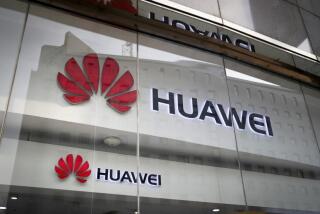FCC Action May Speed Marketing of Pocket Phones
- Share via
WASHINGTON — A move Thursday by the Federal Communications Commission to open up more radio airwaves to telephone services could speed the development and marketing of cheap, tiny pocket phones that could compete with stationary home, office and pay phones linked by copper wire.
The FCC proposed opening up a broad band of radio frequencies now used by electric utilities and railroads to “emerging technologies,” including new mobile telephones.
The proposal is similar to legislation moving through Congress that would transfer some U.S. government-held radio channels to commercial use.
Increased access to the airwaves by new technologies could mean that a person’s home, office and car phones might be replaced by a single wireless phone the size of a pocket calculator that could become as ubiquitous as a watch or wallet.
The greatest impact of such a development might be in markets such as Los Angeles, where there is already a huge demand for mobile phones, increasing competition among vendors.
Such phones, now under development by Motorola and other companies, are less powerful than cellular phones and not good for use in moving cars. But the big market might be consumers who want to take their phone to the beach and business people who need a phone in the field. The phones have high-quality sound and--at an estimated $150 a unit and 20 cents a call--could cost about half as much as car phones now do, said Millard Phelps, an analyst at brokerage Hambrecht & Quist.
Tiny, wireless portable computers using the microwave system could help salespeople and repairmen communicate with computers at headquarters. Even interactive video information could become completely portable.
How soon any of these products hit the market depends on the results of experiments planned by more than 80 U.S. companies, including Pacific Telesis and McCaw Cellular Communications, part-owner of L.A. Cellular.
Glendale-based Cellular Service Inc., a major “reseller,” or retailer of cellular phone service, has also applied for a license to carry out experiments.
“By the year 2000, everyone is going to carry some kind of wireless device. You’ll be a much more efficient, happy person if you don’t have to stand by your phone,” says David Nelson, vice president of Cellular Service Inc.
Charles Schelke, a telecommunications analyst at Smith Barney, Harris Upham, is more conservative, estimating 10% to 15% penetration of pocket phones by the end of the decade, compared to 3% to 4% for cellular phones today.
The reallocation of band widths would be just one of many steps toward wider dissemination of wireless communications. Officials said that the first reallocations could take place within a year, unusually swift by FCC standards. However, full implementation could require 10 to 15 years.
The commission proposed to ease the transition by requiring that new customers buy out existing users and finance their moving to a new frequency or to wired communication networks.
Railroads and electric utilities that use microwaves to link switching and communication systems are expected to fight being forced to give up their frequencies.
Originally, the commission planned to force police and fire agencies to give up some of their space in the radio spectrum. But that proposal was dropped after various agencies protested that it would be too costly and endanger public safety.
Nevertheless, any police or fire department willing to give up its frequency would be able to sell it to new-technology customers. Schelke estimated that rights to a spot on the airwaves in Los Angeles, without any existing communications equipment, could sell for $200 million or more.
Also, Thursday, the FCC allowed an interactive video service to use public airways to provide a service allowing viewers to respond to television shows without using a computer or telephone. TV Answer Inc. of Reston, Va., asked for the change to introduce its interactive video and data device that enables a viewer to bank, pay bills, shop or respond to public opinion polls posed by television shows or commercials.
Moffat reported from Los Angeles and Houston reported from Washington.






